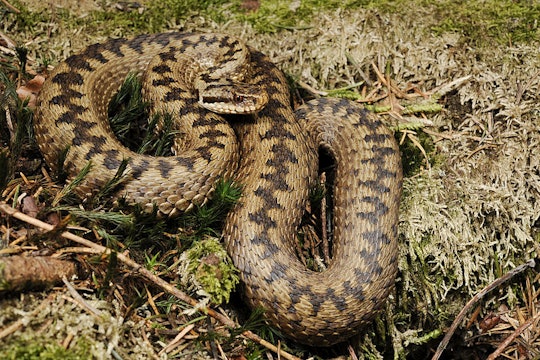
A viper's zig-zag colors help blur their predators' vision
Scientists previously thought that animals' color patterns were either warning signs or camouflage — on these snakes, they are both
Evolutionary biologists are constantly trying to make sense of patterns in nature — from the global-scale patterns of biological diversity to the individual color patterns on an animal’s fur. Prey animals are especially interesting puzzles because of their unique adaptations that help them avoid being eaten. Some evolve extreme camouflage, like stick insects and bottom-dwelling fish. Others consume toxic food which they use as chemical defenses against predators. Toxic or venomous prey often advertise their defenses using bright warning coloration (think wasps, butterflies, and poison frogs). Now, scientists are seeing that venomous snakes can have it both ways: patterns as both advertisement and camouflage.
Snakes may not seem like typical prey animals, but evolutionary biologists actually have a long history of studying snake coloration from an anti-predator perspective. Some venomous snakes, like coral snakes and sea snakes, have the classic black-and-yellow or black-and-red striped pattern that effectively communicates danger to potential predators. In contrast, rattlesnakes use the sound of their rattle as a warning signal instead of relying on their color pattern, which may explain why their coloration is better for camouflage than that of a coral snake.
Recently, biologists have been investigating whether a single color pattern could have evolved multiple defensive functions to protect prey from being seen, attacked, and caught by predators. There's been a lot of focus on European vipers, which have a dark brown or black zig-zag stripe down their back over a light gray or tan background. Although these snakes do not have bright colors, their zig-zag stripe still functions as a warning signal to predators. Studies over the past few decades have confirmed this by measuring the frequency of predator attacks on model vipers made out of clay. These studies have shown that birds attack clay snakes less often if they have a zig-zag stripe than if they are plain-colored or if they have other striped patterns.
While many scientists would leave the story there and accept that the zig-zag stripe evolved solely as a warning signal, evolutionary biologists Janne K. Valkonen and Johanna Mappes went further. In collaboration with researchers at the University of Jyväskylä and the University of Oulu in Finland, Valkonen and Mappes did another clay model experiment, but swapped bird predators for human ones. They hid the model snakes along a hiking trail and asked college students from biology field courses to identify as many as possible while they walked down the trail. College students were worse at finding the snakes with zig-zag stripes than solid-colored ones, indicating that the zig-zag actually provides camouflage in addition to serving as a warning signal.

Many species of stick insect are highly camouflaged due to their body shapes and coloration
But what if a particularly persistent predator managed to spot a striped viper and, despite the warning of danger, attacked anyway? Could the viper’s zig-zag stripe help it to evade capture as well?
The researchers answered this question by examining a particular visual illusion known as ‘flicker fusion’. Imagine sitting in a speeding car and looking out the window at trees in the distance. If the trees are packed very closely together, they may appear to blur into a single brownish streak on the horizon rather than being distinguishable as individual objects. The same effect could occur with the zig-zags of the vipers. If the snakes move fast enough, the back-and-forth of the zig-zag would blur into a diffuse longitudinal stripe. This pattern-changing effect is thought to make fleeing prey harder to catch by confusing predators and reducing their ability to accurately judge the prey’s speed, shape, and location.
Some predators have better vision than others, which could affect their perception of visual illusions. To figure out which predators would experience the flicker fusion effect when hunting vipers, the researchers first had to measure how fast the snakes could move.
They collected live vipers in Finland and filmed them fleeing from a simulated attack (a quick tail tap was enough to scare them). The researchers then used these videos along with close-up photos of the zig-zags to calculate how many of the snakes' light and dark color patches could pass by a single spot within one second. By comparing these calculations to measurements of various predators' flicker fusion thresholds — the maximum rate at which black and white stripes can speed by before they blur together — they determined that European vipers may use this visual illusion to help them elude capture by mammals, although it is unlikely to be effective against birds.
Valkonen, Mappes, and their colleagues recently published these results in Animal Behaviour, and concluded that the zig-zag stripe found on many European vipers can potentially protect them from being seen, attacked, and caught by predators. And even though some predators may overcome a single defense, they are unlikely to hurdle all three. So, while a casual observer might think these vipers’ color patterns only provide aesthetic benefits, this simple zig-zag has proven to be much more powerful than anyone would have predicted.




Sara, this is a great summary of some fascinating research! I like how you highlight the range of pressures faced by organisms. While it might seem like the answer to a question like “why does a snake have this coloration” would be easy to answer, in reality there are so many different factors that can influence the evolution of traits. As this research shows, there is often more than one reason why a trait evolved a certain way.
I am curious, since these patterns appear to serve as a warning signal to birds, is that warning genuine signal or are the vipers mimicking a pattern from another species?